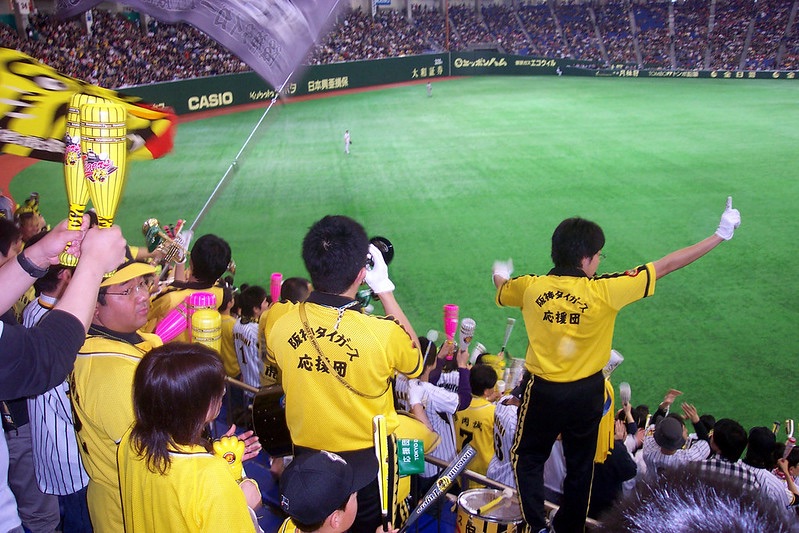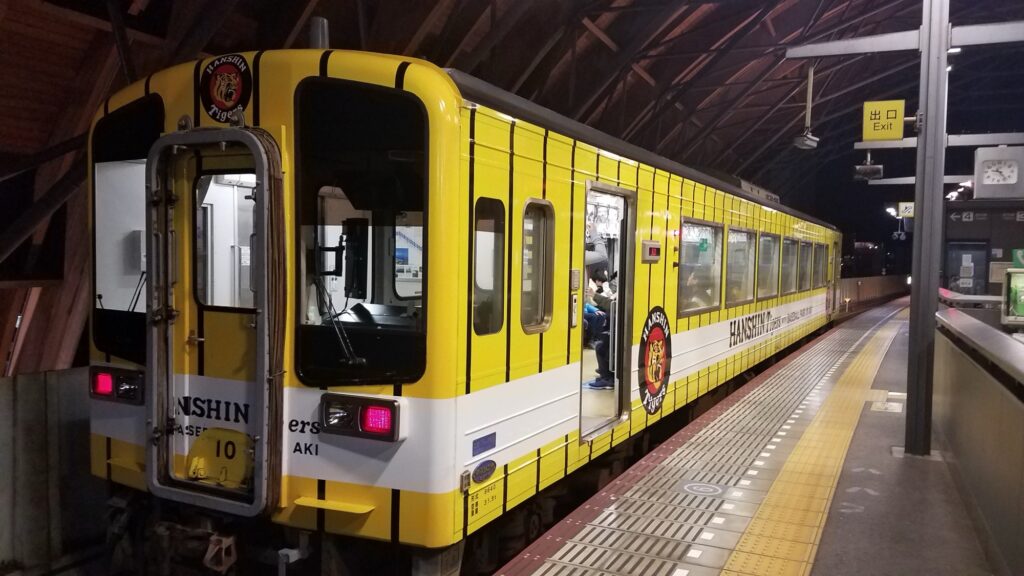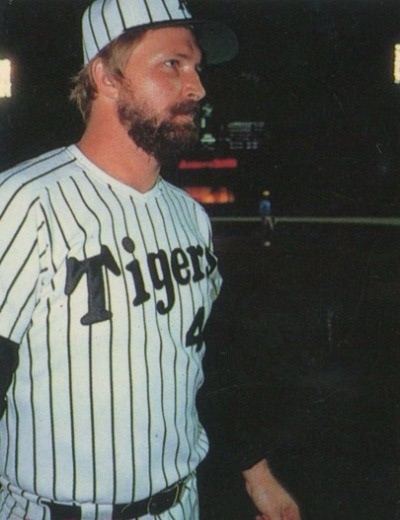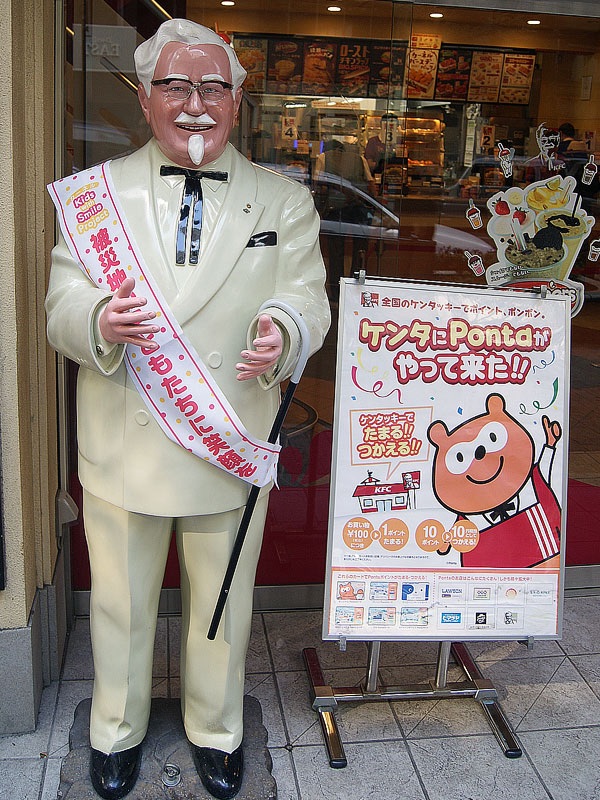The Hanshin Tigers, the Japan Series and the CURSE OF COLONEL SANDERS

I have never been much of a sports fan. Australia is mad about the AFL, my dad loves tennis, and my sister can teach you surfing in a professional capacity, but for me nothing has ever really stuck. But if you live in Japan, and especially if you live in the Kansai area, there is one sport you absolutely must have an opinion on, and that is baseball.
Baseball is, hands down, the most popular sport in Japan. Soccer has been making inroads in recent years, and sumo is the officially the national sport, but baseball is the one thing that everybody knows about. Almost everybody has a team allegiance, which is generally — though not always! — based on where they grew up, and during baseball season, the ascent and descent of the popular teams up and down the ladder is big news.
Nowhere in Japan is this more true than Kansai, the region including Osaka, Kyoto and Kobe. That is the home of the Hanshin Tigers, hands-down the most popular baseball team in Japan. Are they the strongest team? No, definitely not; that accolade belongs to their arch-rivals, the Tokyo-based Yomiuri Giants. Are they the oldest team in Japan? Also no; THAT title belongs to the Yomiuri Giants as well. But are they the weirdest team in Japan? Well, I can’t actually speak to the players themselves, but if we’re talking about the fans, then yes, absolutely.
Even if it’s not the Hanshin Tigers, baseball in Japan is already pretty strange compared to its American counterpart. For a start, each team has a brass band — arranged by the fans, of course — which travels with them even to away games and plays their cheer songs at the correct parts of the match. Each and every player has their own chant, complete with percussion intervals, and all the fans know it and will do it when that player comes to bat. But of course, they can’t just do it in a *disorganized* fashion — the fans also have chant leaders, dressed in the traditional all black ouendan uniform and white gloves, telling people when to start and stop via a series of pre-determined gestures.

But this isn’t specific to the Hanshin Tigers — all major Japanese baseball teams have this. So what is it that makes the Hanshin Tigers stand out? By and large, it has to be their pure enthusiasm. Sure, other teams have fans dressing up as their animal mascots, but at Hanshin Tigers games, a full 80% or more of the crowd are wearing tiger ears, and a huge number have face paint and tiger tails as well. Fans of other teams will travel huge distances to see their team play away matches, but Hanshin Tigers fans often outnumber the home team’s fans at matches in their own stadiums. And then, of course, there is the Hanshin Tigers train.

But the thing the Hanshin Tigers fans are most known for, and the moment that cemented their position as the most outlandish baseball fans in Japan and possibly the world, took place in back in 1985, and involved an unexpected win at the Japan Series, a bridge in the centre of Osaka, American baseball player Randy Bass, and a life-sized fiberglass statue of KFC’s Colonel Sanders.
In the lead up to the 1985 season, the Hanshin Tigers had not been considered a particularly strong team, although even back then their fans were notoriously enthusiastic. They hadn’t won a series since 1964, putting them in a twenty-one year drought, and their 1984 season had only been mediocre. So it was a surprise to everyone, including probably the Hanshin Tigers themselves, when they stormed to a decisive victory in the 1985 Japan Series.
The celebrations in Kansai were huge. Hanshin department store — the sponsors for the Hanshin Tigers — had spontaneous sales, and many other stores joined in, with Hanshin Tigers fans rushing out to buy food and Tigers goods for their victory parties. But the biggest event happened in the centre of Osaka, at the Dotonbori Bridge. At about midnight, a huge, celebrating crowd which had been wandering around the streets of Osaka up until that point, converged on the bridge. Somehow it was decided that, in order to celebrate the victory and show appreciation for the individual players, a member of the crowd who most resembled each member of the team should leap from the bridge into the — honestly quite filthy — water of the Dotonbori canal below.
This went without hitch for 25 players, but for the 26th, the plan suddenly hit a snag. The 26th player, American Randy Bass, had been instrumental in their victory, but in Japan in 1985 there were not many foreigners, and in the group of rowdy fans at Dotonbori Bridge that night, there were none at all. Randy Bass certainly couldn’t be omitted from this display of allegiance, but in the crowd there was nobody who could even remotely be considered to resemble the tall, bearded American.

“Randy Bass With The Hanshin Tigers” by Ieatpotatos is licensed under CC BY-SA 4.0.
The crowd did not let this minor detail stop them, and a solution was quickly found; in Japan, even now, every KFC has a lifesized fiberglass Colonel Sanders statue standing in front of it, welcoming customers to the restaurant. Colonel Sanders was a foreigner, and the mustache and goatee were close enough to a beard — so the fans immediately seized the Colonel statue from the nearest KFC and threw it into the Dotonbori river, where, unsurprisingly, it promptly sank.
The next year, hopes for another Hanshin Tigers victory were high, but the team lost quite ignominiously. This was the beginning of a terrible run of luck lasting many years, with the team only very rarely making any inroads on the rankings at all. It didn’t take long for fans to suspect that something was behind these continued losses, and soon the Colonel’s unwilling dip was recalled; was this retribution for their crimes against fried chicken? An apology visit was made to the manager of the KFC, and the river dredged — more than once! — to try and return the statue, but it was no good. The statue remained missing, and the legend of the Curse of Colonel Sanders took hold.

In 2003, after a drought of eighteen years the Hanshin Tigers won the Central League pennant and made it to the Japan Series final. All the local KFCs moved their Colonel Sanders statues inside, and a huge crowd of Hanshin Tigers fans gathered at the Dotonbori bridge, with over 5,000 people leaping into the canal. However, ultimately the Tigers lost the series final, continuing the curse and their Japan Series no-win streak.
Finally, in 2009, twenty four years after the Colonel’s historic swim, construction workers preparing a section of the river for the addition of a walking path were startled to discover an object that they initially mistook for a barrel, and then a corpse, but which was ultimately identified as the top half of the long-lost Colonel. The bottom half followed soon after, and the Colonel — still missing his left arm and glasses, but otherwise surprisingly intact — was returned at last to Japan’s KFC headquarters.

Was this the end of the Curse of the Colonel? Well, not immediately. Despite high hopes, the Tigers continued to underperform in the rankings — until in 2023 when, in a reflection of their historic 1985 win, the Tigers stormed to an entirely unexpected victory, charging up the ladder and finally defeating the Orix Buffalos in the final 7-1.
The celebrations were immediate and massive. The thousands of fans had gathered on and near the Dotonbori bridge to watch the final on their phones went wild, though with 1,300 police already in attendance, the celebrations were fairly well-behaved. Hanshin department stores immediately started their celebratory sales, including a huge variety of limited-edition victory goods. And one of my students, an eleven year old primary school girl, said to me “we didn’t get any homework this weekend, because the Hanshin Tigers won the series and my teacher was too happy”.
But what about the river? Well, after the events in 2003 when 5000 people flung themselves in, the bridge had been heavily redesigned to prevent people’s ability to jump, and the 1,300 police carefully monitoring everybody’s activities also definitely put a damper on anybody’s water-based aspirations. The original Dotonbori KFC had closed up shop many years prior, and every other KFC even remotely in the area had carefully locked their fiberglass Colonels away weeks in advance — as had any other store with any kind of semi-mobile mascot.
This didn’t stop everyone, of course. You can’t keep a good sports fan down. According to reports the next day, seven people managed to break through the police barricades and make the plunge — including one man dressed as Colonel Sanders.